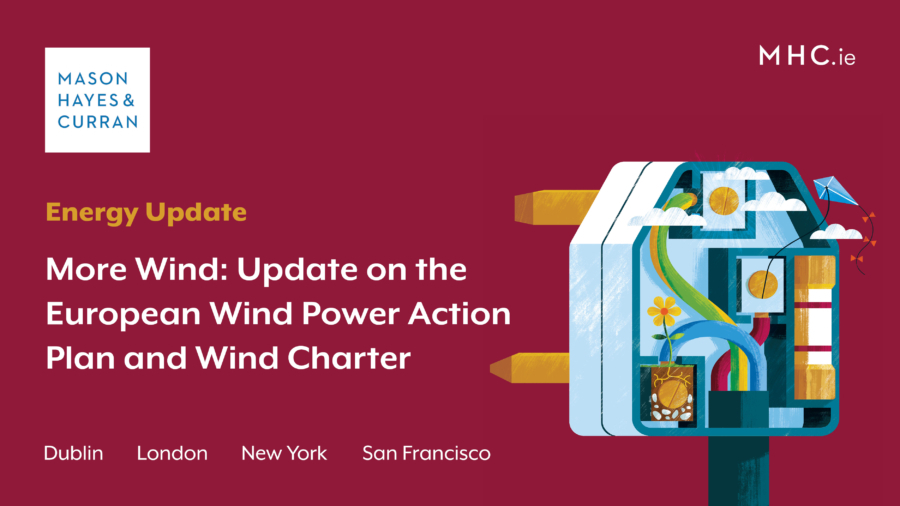
The European Commission recently published the European Wind Power Action Plan. As part of this Plan, EU Member States have signed the European Wind Charter. Energy partners, Rob McDwyer and Eoin Cassidy review the content of the Plan and outline the key commitments made by the signatories of the Charter, which include Ireland.
The European Commission published the European Wind Power Action Plan in October 2023. The European Union target of at least 42.5% renewables by 2030 will require installed wind capacity to more than double, from 204 GW in 2022 to over 500 GW in 2030. The Plan outlines a series of actions for the European Union, Member States and the industry that should be taken to achieve this objective and address current operating challenges. One such action was the signing up by Member States and industry representatives to voluntary commitments under the European Wind Charter.
The Plan is divided into the following six pillars.
1. Acceleration of deployment through increased predictability and faster permitting
Actions under this pillar include accelerating permitting processes through digitalisation and training, and enhancing cooperation between European Union wind energy forums. This pillar also promotes increased visibility of wind project pipelines, and the adoption of an action plan to facilitate the build-out of electricity grids.
2. Improved auction design
This pillar promotes the use of well-designed, objective, transparent, non-discriminatory pre-qualification and non-price award criteria in the auctions for the support of wind energy projects. The Commission will propose a set of auction criteria covering concepts such as cyber security, sustainability, environmental protection and ability to deliver.
3. Access to finance
The Plan lays out several actions designed to facilitate access to European financing and encourage investment in the wind industry. In particular, the European Investment Bank will play a key role in providing funding, de-risking tools and counter-guarantees.
4. Creating a fair and competitive international environment
Actions under this pillar include the facilitation of access by European companies to foreign markets, increased protection of the internal market against trade distortions, and enhancement of standardisation in the wind energy sector.
5. Skills
Under this pillar, the Commission will support large-scale skills partnerships that enhance skills development for the wind sector. It will also facilitate the launch of European net-zero industry skills academies as part of Member State reskilling and upskilling initiatives.
6. Industry engagement and Member State commitments
The final pillar calls on the industry and Member States to take a more active role in matters such as hedging against inflation and price volatility of main manufacturing inputs, such as raw materials, and developing further long-term partnerships between wind manufacturers and operators.
The European Wind Charter
The European Wind Charter was published in December 2023. It builds on the Plan and its policies, and aims to facilitate the rapid implementation of the stated action points.
Ireland signed up to the Charter on 19 December 2023. Most EU member states have already signed up, and more than 300 companies from the wind sector – including wind turbine manufacturers, wind farm developers, owners and operators – have expressed their support.
The Charter, which considers both onshore and offshore wind, focuses on a range of areas, including National Energy and Climate Plans, wind auctions, governance, regulation, and equipment manufacturing.
It includes commitments from the Member States who have signed up to the Charter to:
- Strengthen their collaboration on identifying barriers in permitting procedures, and to work together and with the European Commission in identifying potential new ways to accelerate permitting further
- Improve, simplify and provide consistency in the design of auctions for wind energy
- Remove the remaining barriers to the conclusion of Power Purchase Agreements in line with legal requirements under EU law
- Take appropriate measures to maximise the execution rate of wind projects through appropriate incentives, including penalty clauses for non-execution of projects, and
- Scale up wind equipment manufacturing capacity in the EU to meet the expected increased demand for wind projects
As part of the Charter, Ireland also signed a voluntary ‘wind pledge’ committing to the delivery of onshore wind energy targets for the period 2024-2026. Under this pledge, Ireland has anticipated that its installed onshore wind capacity will grow by 150 MW in 2024, by 500 MW in 2025 and by 250 MW in 2026, by which time the total expected installed onshore wind capacity in Ireland will be 6,050 MW.
Ireland also pledged indicative targets for 2030 of 9 GW of onshore wind generation and 5 GW of offshore wind generation. These targets are consistent with Ireland’s Climate Action Plan 2024, which was approved by the Government on 20 December 2023.
Realising Europe’s decarbonization goals will require a significant increase in installed wind generation capacity. The Plan and Charter together signal that participants in the Irish renewable electricity sector should continue to expect a programme of changes – hopefully positive – in the related regulatory processes.
For more information, contact a member of our Energy or Construction, Infrastructure and Utilities team.
People also ask
What is the EU offshore wind target for 2030? |
The European Union’s offshore renewable energy strategy, published in November 2020, set the Union’s offshore wind target for 2030 at 60 GW. |
What is the climate target plan for 2030? |
The 2030 Climate Target Plan is a European Union initiative that proposes a cut in greenhouse gas emissions of at least 50 to 55% from 1990 levels by 2030. |
What is the EU’s climate ambition for 2030 and 2050? |
The European Union aims to (1) reduce greenhouse gas emissions by between 50 and 55% from 1990 levels by 2030 and (2) achieve net-zero emissions by 2050. |
The content of this article is provided for information purposes only and does not constitute legal or other advice.
Share this:





